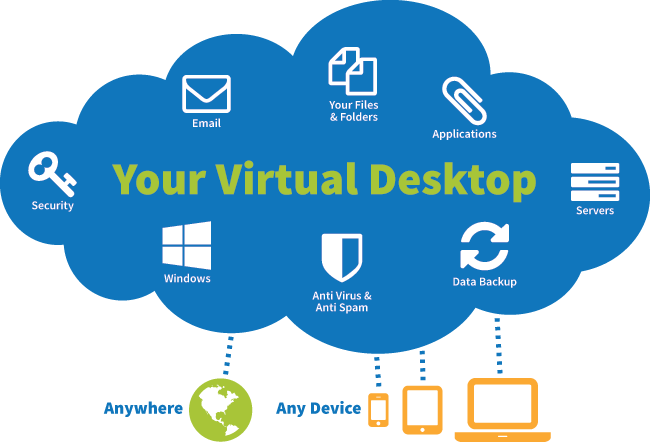VDI Meaning
Unveiling the World of VDI: Understanding the Meaning and Impact
Introduction: In the ever-evolving landscape of technology, Virtual Desktop Infrastructure (VDI) has emerged as a transformative solution, revolutionizing the way organizations manage and deliver desktop environments to end-users. VDI represents a paradigm shift from traditional desktop computing, offering enhanced flexibility, security, and centralized control. This article aims to explore the meaning of VDI, its key components, and the impact it has on modern workplaces.
VDI Meaning
What is VDI?
Virtual Desktop Infrastructure, or VDI, is a virtualization technology that enables the hosting and delivery of desktop environments on a centralized server. Instead of running operating systems and applications on individual physical devices, VDI allows these workloads to be executed in a virtualized environment. Users access their desktops remotely, interacting with the virtualized system through thin clients, PCs, or other devices.
VDI Meaning
Components of VDI:
- Hypervisor:
- At the core of VDI is a hypervisor, also known as a Virtual Machine Monitor (VMM). This software layer is responsible for creating and managing virtual machines (VMs) on a physical server. It allocates resources, such as CPU, memory, and storage, to each VM.
- Virtual Machines:
- Virtual machines are the individual instances of operating systems and applications within the VDI infrastructure. Each user typically has a dedicated VM, ensuring isolation and customization based on their requirements.
- Connection Broker:
- The connection broker acts as an orchestrator, managing the assignment of users to specific virtual machines. It ensures a seamless and balanced distribution of resources, optimizing performance across the VDI environment.
- User Interfaces:
- End-users interact with the VDI through user interfaces, which can be traditional PCs, laptops, thin clients, or even mobile devices. These interfaces provide a window into the virtualized desktop environment.
- Storage:
- Storage is a critical component of VDI, influencing performance and scalability. VDI environments often leverage technologies like Storage Area Networks (SANs) or Network-Attached Storage (NAS) to store virtual machine images and user data.
VDI Meaning
Understanding VDI Deployment Models:
- Persistent VDI:
- In a persistent VDI model, each user is assigned a dedicated virtual machine that maintains their personalized settings, applications, and data across sessions. This model is akin to traditional desktop computing and suits scenarios where users require consistent and customized environments.
- Non-Persistent VDI:
- Non-persistent VDI utilizes shared virtual machines that reset to a standard configuration after each session. This approach is more streamlined and efficient, making it ideal for scenarios where users’ needs are relatively standardized, such as call centers.
VDI Meaning
The Impact of VDI on Modern Workplaces:
- Enhanced Flexibility:
- VDI liberates users from the constraints of physical devices, allowing them to access their desktop environments from anywhere with an internet connection. This flexibility is especially valuable in the era of remote work and bring-your-own-device (BYOD) policies.
- Centralized Management:
- VDI centralizes the management of desktop environments, enabling IT administrators to efficiently deploy updates, patches, and security measures from a central location. This centralized control enhances security and simplifies maintenance tasks.
- Cost Efficiency:
- By reducing the reliance on physical hardware and enabling more efficient use of resources, VDI can contribute to cost savings. The ability to repurpose older hardware and the potential for energy savings are additional factors that make VDI an economically viable solution.
- Improved Security:
- VDI enhances security by keeping data and applications within the data center. This centralized approach reduces the risk of data loss or unauthorized access associated with end-user devices.
- Scalability:
- VDI allows organizations to scale their desktop infrastructure easily. Adding or removing virtual desktops to accommodate changing business needs is more straightforward than managing physical desktops.
VDI Meaning
Challenges and Considerations:
While VDI offers numerous benefits, organizations must also consider challenges such as initial implementation costs, network bandwidth requirements, and user resistance to change. Additionally, the choice between persistent and non-persistent models depends on the specific needs of the user base.
VDI Meaning
Conclusion:
Virtual Desktop Infrastructure represents a significant evolution in desktop computing, offering a flexible, secure, and scalable solution for modern workplaces. As technology continues to advance, VDI will likely play a pivotal role in shaping the future of how organizations manage their desktop environments, providing a bridge to a more dynamic and adaptive computing landscape. Understanding the meaning and impact of VDI is essential for businesses looking to embrace the efficiencies and advantages offered by this innovative technology.
VDI Meaning




Comments
0 comments